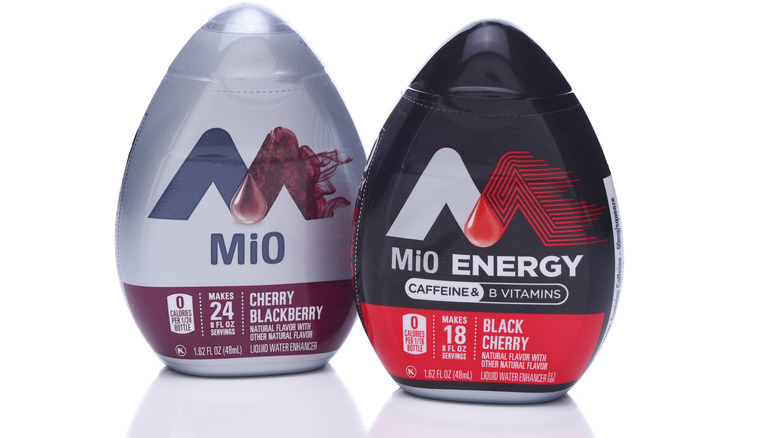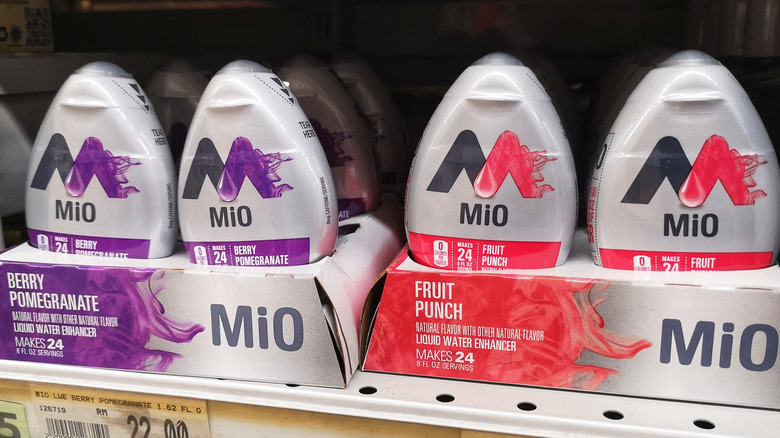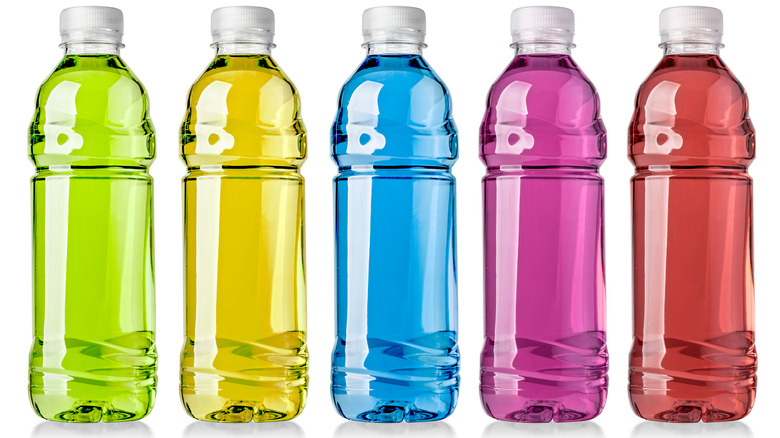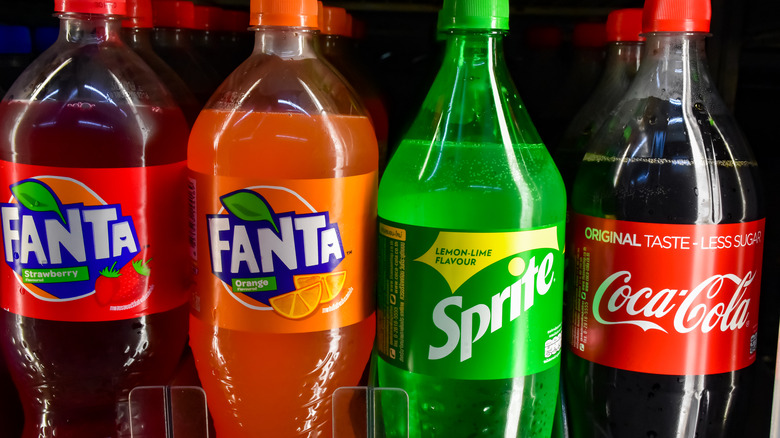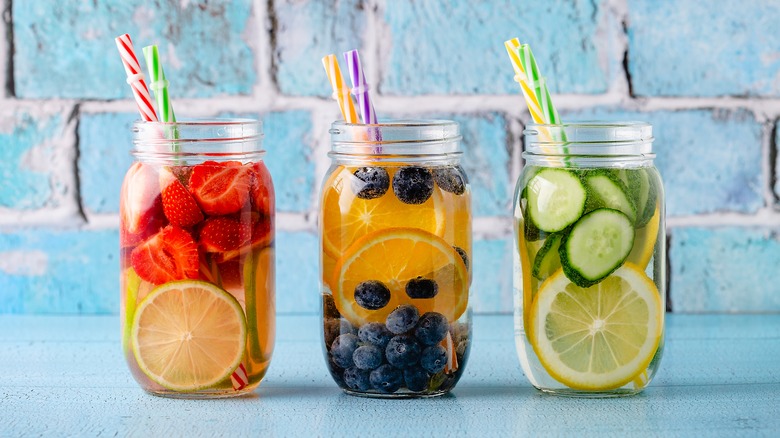Is MiO Good For You?
MiO is a calorie-free, sugar-free flavored water enhancer found on most grocery store shelves. It comes in a variety of flavors, and all you have to do is dilute a few drops into a glass of water for a flavorful beverage option. But are these drinks healthy?
One obvious benefit to using MiO is if you struggle to drink enough water during the day because you don't like the taste of plain water. Adding a flavor-booster like MiO could help prevent dehydration. Additionally, if you tend to drink a lot of soda, juice, or other drinks with high amounts of sugar, MiO could be a great alternative. However, it's unlikely you'll get much nutritional value from the drink.
To better assess MiO's health profile, let's take a closer look at some of the product's main ingredients, as listed on the label: citric acid, propylene glycol, natural flavor, sucralose and acesulfame potassium as sweeteners, and the food dyes Red 40 and Blue 1 (via My Food and Family).
Ingredients with lesser known risk
Citric acid is an artificial compound added to packaged food to preserve freshness for a longer period of time. While the FDA recognizes it as generally safe, some health experts say it may cause stomach upset and dental cavities (via WebMD). The risks of ingesting foods with citric acid appear to be minimal as of now.
Propylene glycol is a synthetic chemical compound also recognized as "generally safe" by the FDA for use in various things like food and cosmetics. However, it has received backlash due to the fact that it's also found in coolants and antifreeze (per CDC). Despite its widely applied usage, it isn't considered toxic to humans unless consumed in very large amounts.
Natural flavors may or may not be harmful. The reason we don't know is because the term "natural flavors" in food manufacturing could mean many things. There's currently no standard legal definition set forth by the FDA (via Food Drug Law Journal). Unfortunately, this label can be misleading. While it's generally used as a broad definition that can include any essence or extract derived from things in nature, it can also contain artificial and synthetic ingredients as well, and often does.
Ingredients that may have greater risk
When we think of the potential downsides to calorie-free, sugar-free beverages, we usually think of what's used to sweeten them — namely, artificial sweeteners. MiO contains sucralose and acesulfame potassium, two common artificial sweeteners found in diet food and beverages. Controversies remain over whether or not artificial sweeteners are harmful to our health, particularly with regard to carcinogenesis and cancer risk (via the Journal of Pharmacology and Pharmacotherapeutics).
Food dyes are controversial for their health impacts, yet are still found in a wide variety of packaged food items. Red 40 has been linked to carcinogenic compounds and hypersensitivity responses in animals, via the International Journal of Occupational and Environmental Health. Interestingly, Red 40 is restricted in Europe, with food products containing the ingredient required to have a warning label (per the New York Times). Meanwhile, Blue 1 has also been linked to hypersensitivity reactions in animal studies. While the FDA allows dyes to be used in U.S. foods, the Center for Science in the Public Interest petitioned to ban them in 2008. It remains unclear whether or not there are any short or long-term health impacts of food dyes, but many health experts are skeptical.
How does MiO stack up against soda?
While MiO may contain some questionable ingredients, soda also contains several additives that are harmful to your health. WebMD reports that sodas (regular and diet) have been linked to several health conditions including high blood pressure, kidney damage, stroke, and some cancers. A 2011 study published in the journal Physiology & Behavior showed that sugary drinks, including soda, increased the risk of developing obesity and type 2 diabetes.
MiO is calorie-free, and if you are looking to lose weight or maintain your current weight, it might be a better option than sodas. That's because one can of soda can contain up to 10 teaspoons of sugar, according to the CDC. 12 ounces of an average soda contains around 155 calories, but some can contain as much as 195 calories. Energy drinks have even more calories, with some weighing in at 280 calories (via MedlinePlus).
Healthier ways to flavor your water
Since MiO doesn't provide your body with any nutritional value, it isn't exactly good for you. That said, it's not necessarily bad for you either. The best way to enjoy it is in moderation, according to Harvard Health Publishing.
If you're looking for healthier ways to flavor your water, one option is adding fruits, spices, and herbs to it. Berries and slices of lemons, limes, or cucumbers will liven up a glass of water, according to the CDC. If you're craving fizz, you could try adding a bit of 100% juice to plain sparkling water.
But there's no need to stop there. Another recipe you can try is adding one cup of watermelon and two to three basil sprigs to a jar of water (via the U.S. Department of Agriculture). Alternatively, you can mix ⅓ cup of diced mango with ¼" of ginger root. If you like cinnamon, try adding a dash of the spice with ¼ of an orange, an ⅛ of a teaspoon of vanilla extract, and half of a teaspoon of cardamom. All you need to do is add the ingredients to your water and let it sit for a few minutes. Infuser bottles can also help do the job.

